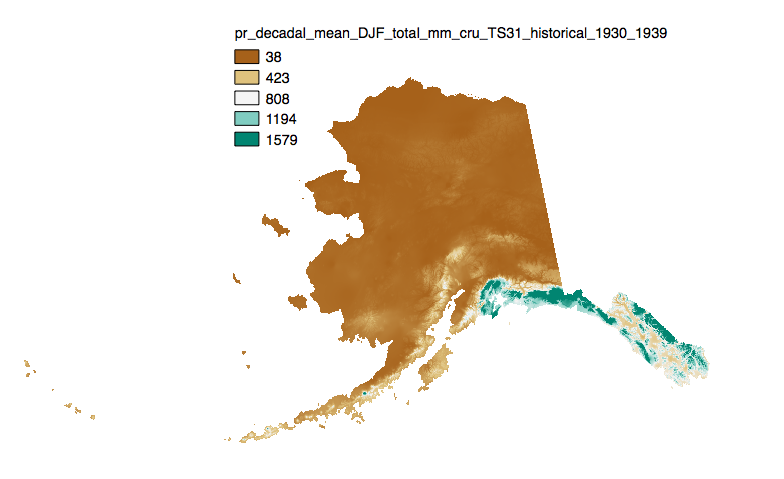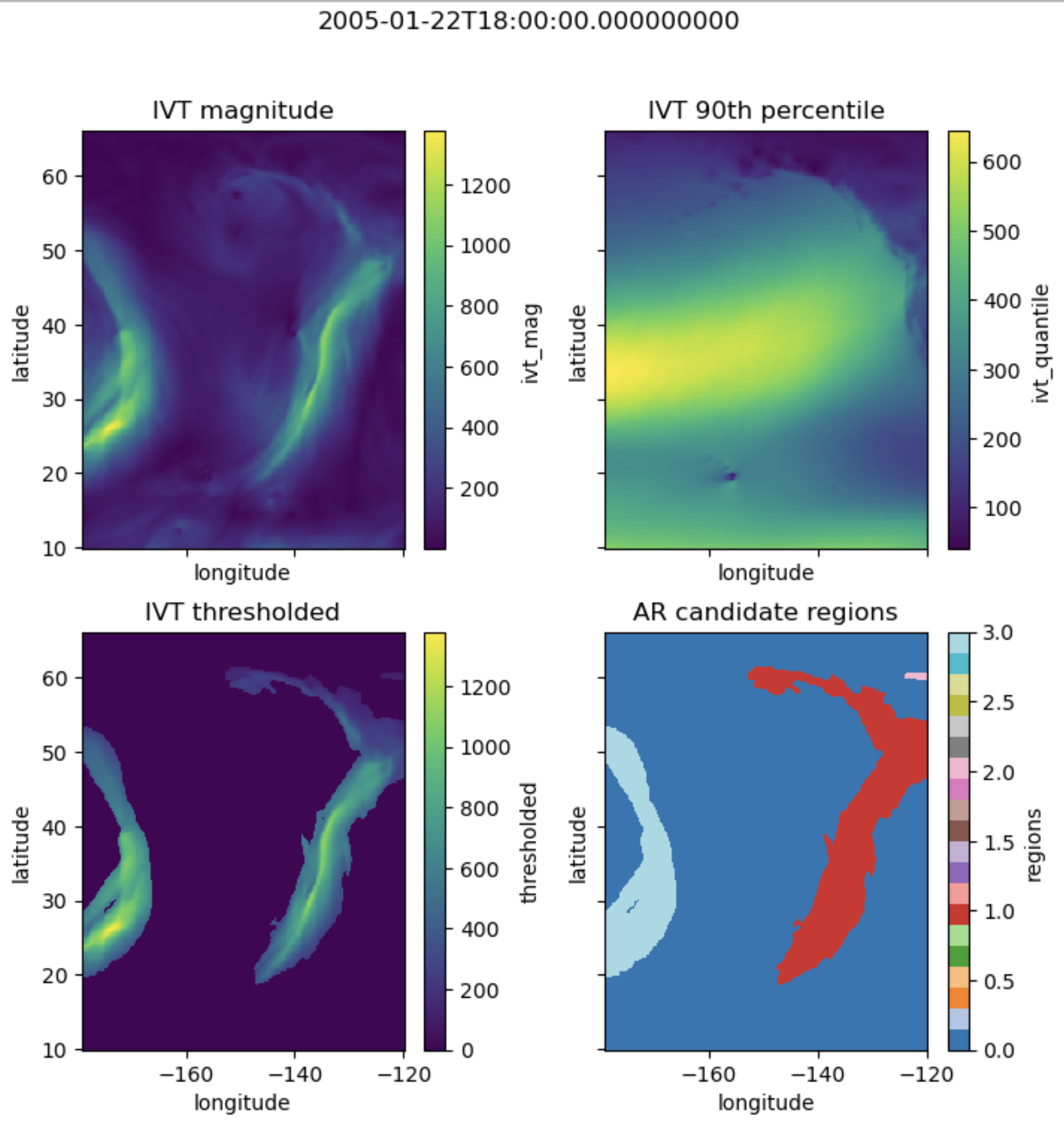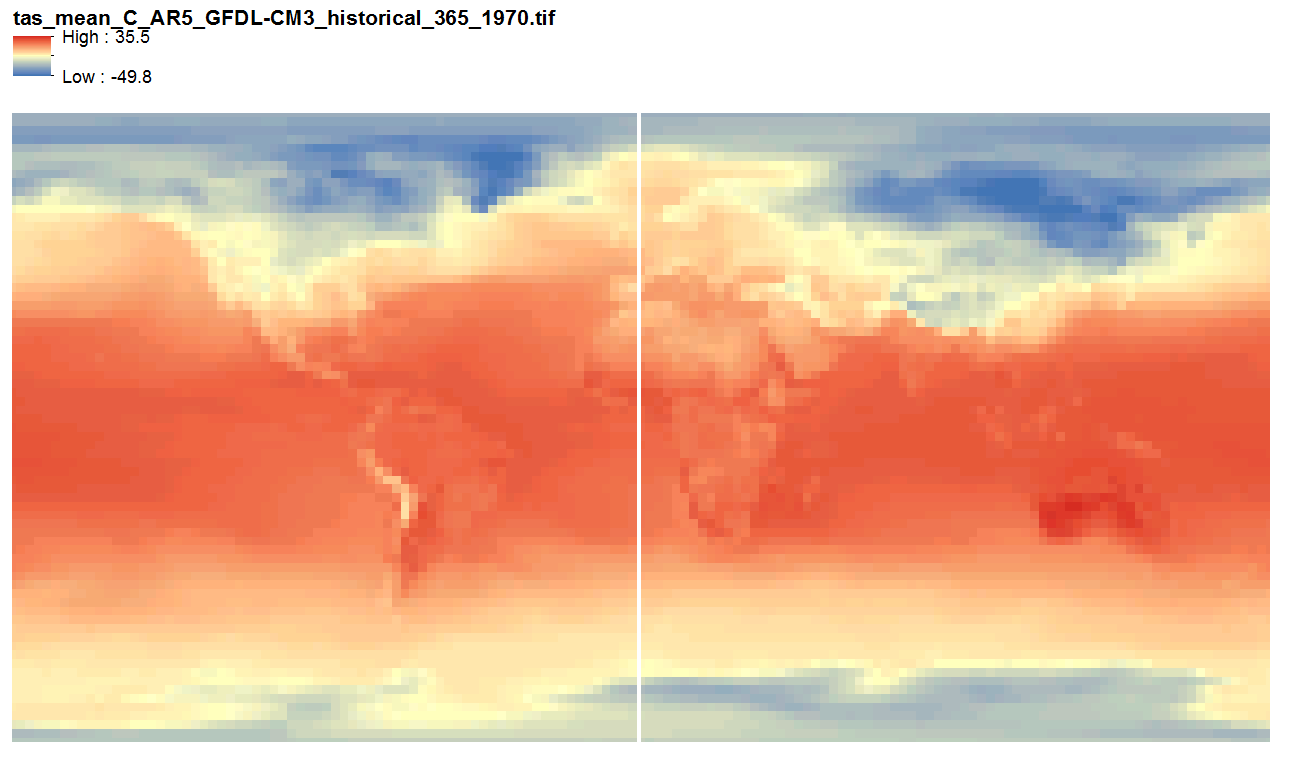climatologyMeteorologyAtmosphere
Type of resources
Topics
Keywords
Contact for the resource
Provided by
Years
Formats
Representation types
Update frequencies
status
Scale
Resolution
-

This set of files includes downscaled historical estimates of monthly total precipitation (in mm, no unit conversion necessary) from 1901 - 2005, at 15km x 15km spatial resolution. They include data for Alaska and Western Canada. Each set of files originates from one of five top ranked global circulation models from the CMIP5/AR5 models and RCPs, or is calculated as a 5 Model Average. These outputs are from the Historical runs of the GCMs. The downscaling process utilizes CRU CL v. 2.1 climatological datasets from 1961-1990 as the baseline for the Delta Downscaling method.
-

This dataset contains climate "indicators" (also referred to as climate indices or metrics) computed over one historical period (1980-2009) using the NCAR Daymet dataset, and two future periods (2040-2069, 2070-2099) using two statistically downscaled global climate model projections, each run under two plausible greenhouse gas futures (RCP 4.5 and 8.5). The indicators within this dataset include: hd: “Hot day” threshold -- the highest observed daily maximum 2 m air temperature such that there are 5 other observations equal to or greater than this value. cd: “Cold day” threshold -- the lowest observed daily minimum 2 m air temperature such that there are 5 other observations equal to or less than this value. rx1day: Maximum 1-day precipitation su: "Summer Days" –- Annual number of days with maximum 2 m air temperature above 25 C dw: "Deep Winter days" –- Annual number of days with minimum 2 m air temperature below -30 C wsdi: Warm Spell Duration Index -- Annual count of occurrences of at least 5 consecutive days with daily mean 2 m air temperature above 90th percentile of historical values for the date cdsi: Cold Spell Duration Index -- Same as WDSI, but for daily mean 2 m air temperature below 10th percentile rx5day: Maximum 5-day precipitation r10mm: Number of days with precipitation > 10 mm cwd: Consecutive wet days –- number of the most consecutive days with precipitation > 1 mm cdd: Consecutive dry days –- number of the most consecutive days with precipitation < 1 mm
-

These files include downscaled historical decadal average monthly snowfall equivalent ("SWE", in millimeters) for each month at 771 x 771 m spatial resolution. Each file represents a decadal average monthly mean. Historical data for 1910-1919 to 1990-1999 are available for CRU TS3.0-based data and for 1910-1919 to 2000-2009 for CRU TS3.1-based data.
-

This set of files includes downscaled historical estimates of monthly total precipitation (in millimeters) at 1 kilometer spatial resolution. Each file represents a single month in a given year. The original SNAP downscaled precipitation product at 2 kilometer spatial resolution was resampled to 1 kilometer spatial resolution via bilinear interpolation to create these data for input to the Integrated Ecosystem Model (IEM). Please note that this data is used to fill in a gap in available data for the IEM and does not constitute a complete or precise measurement of this variable in all locations.
-
This dataset consists of four different sub-datasets: degree days below 65°F (or "heating degree days"), degree days below 0°F, degree days below 32°F (or "freezing index"), and degree days above 32°F (or "thawing index"). All were derived from the same dataset of outputs from dynamically downscaling one reanalysis (ERA-Interim) and two CMIP5 GCMs (GFDL-CM3, NCAR-CCSM4) over Alaska using the Weather Research and Forecasting model (WRF). Data from the GCMs are driven exclusively by the RCP 8.5 emissions scenario. Heating degree days, degree days below 0°F, and freezing index were computed in the following way: subtract the daily mean temperature values from the threshold value and compute the sum of this time series for the given calendar year. Thawing index is instead computed as the annual sum of the quantities resulting from subtracting the threshold (32°F) from the daily mean temperature values.
-

This set of files includes downscaled historical estimates of monthly totals, and derived annual, seasonal, and decadal means of monthly total precipitation (in millimeters, no unit conversion necessary) from 1901 - 2006 (CRU TS 3.0) or 2009 (CRU TS 3.1) at 771 x 771 meter spatial resolution.
-

This dataset includes 42,120 GeoTIFFs (spatial resolution: 12 km) that represent decadal (15 decades between 1950-2099) means of monthly summaries of the following variables (units, abbreviations and case match those used in the source daily resolution dataset). There are three distinct groups of variables: Meteorological, Water State, and Water Flux. Meteorological Variables - tmax (Maximum daily 2-m air temperature, °C) - tmin (Minimum daily 2-m air temperature, °C) - pcp (Daily precipitation, mm per day) Water State Variables - SWE (Snow water equivalent, mm) - IWE (Ice water equivalent, mm) - SM1 (Soil moisture layer 1: surface to 0.02 m depth, mm) - SM2 (Soil moisture layer 2: 0.02 m to 0.97 m depth, mm) - SM3 (Soil moisture layer 3: 0.97 m to 3.0 m depth, mm) Water Flux Variables - RUNOFF (Surface runoff, mm per day) - EVAP (Actual evapotranspiration, mm per day) - SNOW_MELT (Snow melt, mm per day) - GLACIER_MELT (Ice melt, mm per day) Monthly summary functions, or how the daily frequency source data are condensed into a single monthly value, are as follows: - Sum: pcp, SNOW_MELT, EVAP, GLACIER_MELT, RUNOFF - Mean: tmin, tmax, SM1, SM2, SM3 - Maximum: IWE, SWE The model-scenario combinations used to represent various plausible climate futures are: - ACCESS1-3, RCP 4.5 - ACCESS1-3, RCP 8.5 - CanESM2, RCP 4.5 - CanESM2, RCP 8.5 - CCSM4, RCP 4.5 - CCSM4, RCP 8.5 - CSIRO-Mk3-6-0, RCP 4.5 - CSIRO-Mk3-6-0, RCP 8.5 - GFDL-ESM2M, RCP 4.5 - GFDL-ESM2M, RCP 8.5 - HadGEM2-ES, RCP 4.5 - HadGEM2-ES, RCP 8.5 - inmcm4, RCP 4.5 - inmcm4, RCP 8.5 - MIROC5, RCP 4.5 - MIROC5, RCP 8.5 - MPI-ESM-MR, RCP 4.5 - MPI-ESM-MR, RCP 8.5 - MRI-CGCM3, RCP 4.5 - MRI-CGCM3, RCP 8.5 The .zip files that are available for download are organized by variable. One .zip file has all the models and scenarios and decades and months for that variable. Each GeoTIFF file has a naming convention like this: {climate variable}_{units}_{model}_{scenario}_{month abbreviation}_{summary function}_{decade start}-{decade end}_mean.tif Each GeoTIFF has a 12 km by 12 km pixel size, and is projected to EPSG:3338 (Alaska Albers).
-

Atmospheric rivers (ARs) were detected from ERA5 6hr pressure level data, using a detection algorithm adapted from Guan & Waliser (2015). The algorithm uses a combination of vertically integrated water vapor transport (IVT), geometric shape, and directional criteria to define ARs. See the sources listed below and the GitHub repository for more detail and other references. The AR database is a zipped archive containing multiple attributed shapefiles. Polygon data includes individual timestep ARs, ARs making landfall in Alaska, and aggregated landfalling AR events. Point data includes coastal impact points landfalling AR events.
-

This set of files includes downscaled projections of decadal means of annual day of freeze or thaw (ordinal day of the year), and length of growing season (numbers of days, 0-365) for each decade from 2010 - 2100 at 2km x 2km meter spatial resolution. Each file represents a decadal mean of an annual mean calculated from mean monthly data. ---- The spatial extent includes Alaska, the Yukon Territory, British Columbia, Alberta, Saskatchewan, and Manitoba. Each set of files originates from one of five top ranked global circulation models from the CMIP5/AR5 models and RPCs, or is calculated as a 5 Model Average. Day of Freeze, Day of Thaw, Length of Growing Season calculations: Estimated ordinal days of freeze and thaw are calculated by assuming a linear change in temperature between consecutive months. Mean monthly temperatures are used to represent daily temperature on the 15th day of each month. When consecutive monthly midpoints have opposite sign temperatures, the day of transition (freeze or thaw) is the day between them on which temperature crosses zero degrees C. The length of growing season refers to the number of days between the days of thaw and freeze. This amounts to connecting temperature values (y-axis) for each month (x-axis) by line segments and solving for the x-intercepts. Calculating a day of freeze or thaw is simple. However, transitions may occur several times in a year, or not at all. The choice of transition points to use as the thaw and freeze dates which best represent realistic bounds on a growing season is more complex. Rather than iteratively looping over months one at a time, searching from January forward to determine thaw day and from December backward to determine freeze day, stopping as soon as a sign change between two months is identified, the algorithm looks at a snapshot of the signs of all twelve mean monthly temperatures at once, which enables identification of multiple discrete periods of positive and negative temperatures. As a result more realistic days of freeze and thaw and length of growing season can be calculated when there are idiosyncrasies in the data. Please note that these maps represent climatic estimates only. While we have based our work on scientifically accepted data and methods, uncertainty is always present . Uncertainty in model outputs tends to increase for more distant climatic estimates from present day for both historical summaries and future projections.
-

This dataset includes quantile-mapped historical and projected model runs of AR5 daily mean mean temperature (tas, degrees C) for each day of every year from 1958 - 2100 at 2.5 x 2.5 degree spatial resolution across 3 CMIP5 models. They are 365 multi-band geotiff files, one file per year, each band representing one day of the year, with no leap years.
 SNAP GeoNetwork
SNAP GeoNetwork